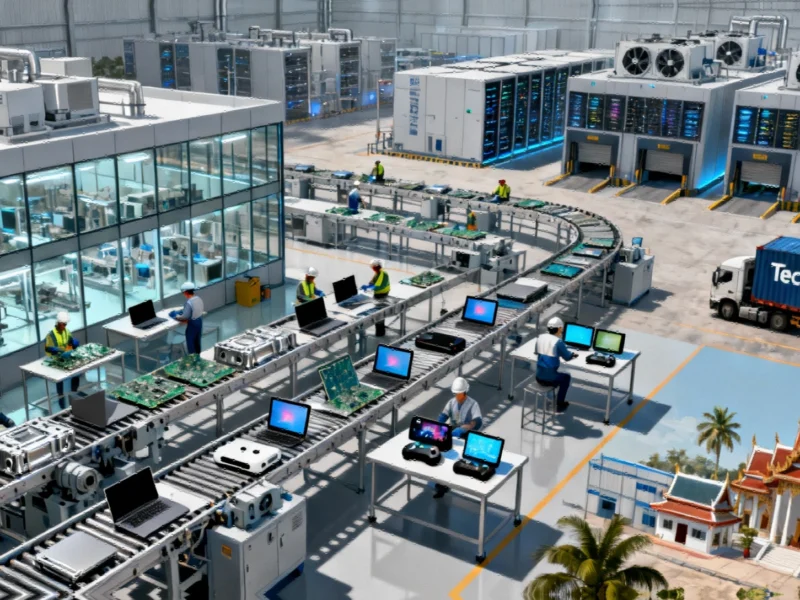Major technology corporations are undertaking significant supply chain realignments as geopolitical tensions between the United States and China continue to escalate. According to recent reports, industry leaders Microsoft, Amazon Web Services, and Google are actively diversifying their manufacturing and component sourcing away from Chinese facilities, marking a substantial shift in global technology production strategies.
Microsoft’s Ambitious Relocation Timeline
Microsoft has set an aggressive target to move up to 80% of its Surface device and data center component production outside China by 2026. The company’s comprehensive strategy encompasses both component manufacturing and final assembly for future notebook computers and server products. Industry sources describe the scope of this transition as “quite wide,” indicating a fundamental restructuring of Microsoft’s manufacturing footprint.
The software giant is reportedly directing existing partners to establish manufacturing capabilities outside China beginning next year. Additionally, Microsoft is accelerating efforts to relocate some Xbox gaming console production to other Asian locations. This strategic pivot reflects broader industry trends, as detailed in recent analysis of technology supply chain diversification efforts across multiple sectors.
AWS and Google Follow Suit
Amazon Web Services is reevaluating its long-standing relationship with Chinese supplier SYE, considering reduced purchases of printed circuit boards for its AI data centers. The cloud computing division has conducted detailed assessments of alternative sourcing options and manufacturing locations to mitigate potential disruptions.
Google is simultaneously advancing its own diversification strategy, pushing suppliers to increase server production capacity in Thailand. The search giant has already secured multiple manufacturing partners in the Southeast Asian nation for components, parts, and final assembly operations. These moves parallel global innovation trends in technology manufacturing that emphasize geographic diversification and risk mitigation.
Implementation Challenges and Industry Context
Despite these ambitious plans, industry analysts note that rapid supply chain relocation presents substantial challenges. China’s established technological expertise and manufacturing infrastructure remain difficult to replicate elsewhere. The complexity of modern electronics supply chains, involving thousands of specialized components, means that complete diversification cannot occur overnight.
The current supply chain shifts occur against a backdrop of escalating trade measures between the US and China, including reciprocal tariff increases, tightened export controls on critical components, and restrictions on technology sales. These developments align with broader international economic cooperation frameworks that increasingly emphasize supply chain resilience and security.
Technological Innovation and Future Directions
As technology companies restructure their manufacturing networks, they’re also investing in innovative production technologies that could further transform supply chain dynamics. Advanced cooling solutions, such as laser-based chip cooling technologies, represent the type of innovation that could influence future manufacturing location decisions.
The coordinated nature of these supply chain adjustments suggests a strategic industry response to persistent geopolitical uncertainties. Technology firms are balancing cost considerations against risk management priorities, creating a new calculus for global manufacturing distribution. This approach mirrors regulatory cooperation initiatives emerging in other technology-forward regions.
Long-term Industry Implications
The collective actions of Microsoft, AWS, and Google signal a potential tipping point in global technology manufacturing. While China will likely remain an important production hub for the foreseeable future, its dominance in certain technology sectors appears to be moderating as companies pursue multi-regional sourcing strategies.
Industry observers will closely monitor how these supply chain transitions affect product costs, delivery timelines, and technological innovation. The success or challenges encountered by these early movers could establish patterns that other technology manufacturers will follow in the coming years, potentially reshaping the global industrial computing landscape for decades to come.
Based on reporting by {‘uri’: ‘techcrunch.com’, ‘dataType’: ‘news’, ‘title’: ‘TechCrunch’, ‘description’: ‘Tech news with an emphasis on early stage startups, raw innovation, and truly disruptive technologies. Got a tip? [email protected]’, ‘location’: {‘type’: ‘place’, ‘geoNamesId’: ‘5391959’, ‘label’: {‘eng’: ‘San Francisco’}, ‘population’: 805235, ‘lat’: 37.77493, ‘long’: -122.41942, ‘country’: {‘type’: ‘country’, ‘geoNamesId’: ‘6252001’, ‘label’: {‘eng’: ‘United States’}, ‘population’: 310232863, ‘lat’: 39.76, ‘long’: -98.5, ‘area’: 9629091, ‘continent’: ‘Noth America’}}, ‘locationValidated’: False, ‘ranking’: {‘importanceRank’: 175185, ‘alexaGlobalRank’: 1802, ‘alexaCountryRank’: 764}}. This article aggregates information from publicly available sources. All trademarks and copyrights belong to their respective owners.



